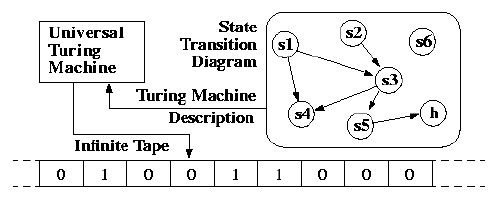Turing Machine
- A machine operates on a infinite tape. On this tape are symbols, which the machine can read and write, one at a time, using a tape head. Operation is fully determined by a finite set of elementary instructions.

- Despite the model’s simplicity, given any computer algorithm, a Turing machine capable of simulating that algorithm’s logic can be constructed.(Incredibly powerful)
| same program | different program | |
|---|---|---|
| same data | remains the same | click |
| different data | click | - |
Universal Turing Machine
A Universal Turing Machine can simulate any arbitrary Turing machine on arbitrary input. - A Turing machine computes a certain fixed partial computable function. - A Turing Machine has finite states. Hence, we’re capable of encoding those states. - Programable: by reading both the description of the machine to be simulated as well as the input from its own tape.
Given the appropriate program, a Universal Turing Machine is capable of computing anything that is computable.
Turing Equivalance
2 computers P and Q are called equivalent if P can simulate Q and Q can simulate P.
Turing Complete
A system that can simulate a universal Turing machine is called Turing complete. - Examples: Most programming languages if memory limit is ignored. E.g. C, C++, Python… - Non Turing complete languages: regular languages generated by regular expression, context free grammar
Misc
Von Neumann Model
Developed based on UTM.

- 4 main components: CU, ALU, memory, I/O
- Programs must be stored in the memory.
- Finite instructions(why?)
- Sequential execution: instructions will be fetched, decoded, and executed one after another, even if there is a jump to previous/following instructions.
- e.g.
- jump to 4
- add x and y
- jump to 2
- jump to 2
- e.g.
Questions
- What’s a Turing Machine?
- Is a calculator Turing complete? Give an explaination.
- Explain the Von Neumann Model.
